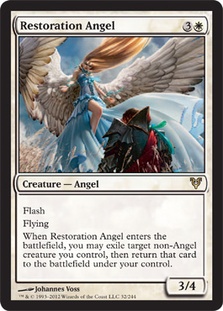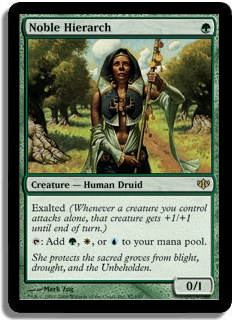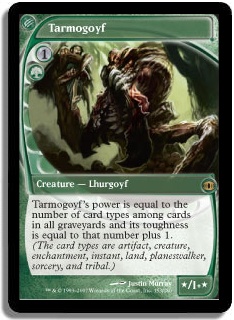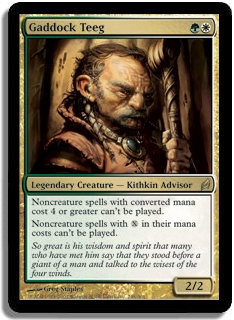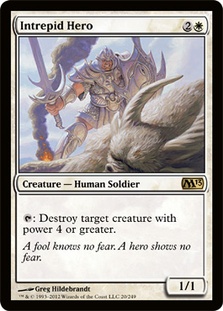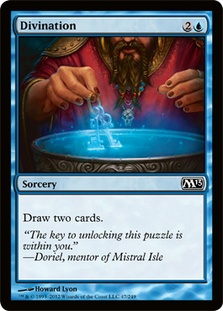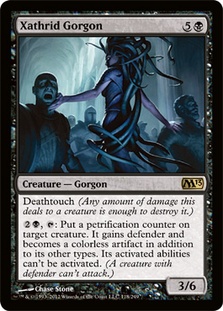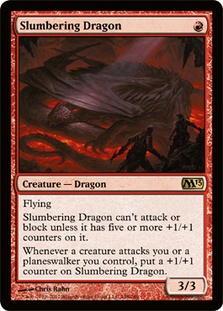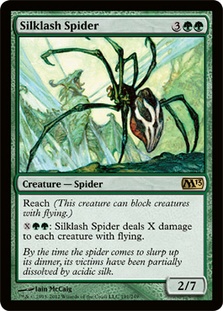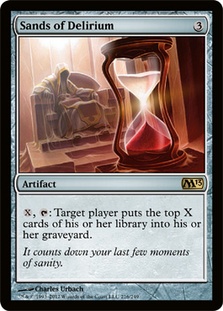I may have set a new record for myself. I changed Modern decks for Grand Prix Columbus with four minutes left in registration. The crazy part? I have no regrets about it.
This is the deck I almost registered at Grand Prix Columbus. You may also view this as the bullet I quite barely dodged.
Creatures (15)
Lands (24)
Spells (21)
Sideboard

This deck was very good before Avacyn Restored. You were able to jam straight through most interaction, often by just comboing off again with your eight copies of each half. You were fast enough against the non-interactive aggro decks to go off almost every game, especially with the roadblocks created by Deceiver Exarch and Spellskite. In combo mirrors, you always had the most disruption.
Restoration Angel changes all of this.
Pod is now significantly better. The difference between two and three cards is at least a full turn, not even counting the fact that infinite life isn’t relevant to Twin if you can kill a combo piece the next turn. If you were just straight up racing you could easily fight that, but this issue is compounded by their access to maindeck hate. Melira gave you time to find the answer for their Linvala, but Kiki-Angel does not. The same also applies to Spellskite, which is now significantly harder to beat with Kiki-Jiki and Deceiver Exarch. I know I mentioned my dislike of permanent-based hate in my last article, but when you have eight Tutors for it things will work out in your favor.
In the blue decks, Restoration Angel gives your opponents a way to apply pressure without ever tapping out. Just Vendilion Clique was not enough, but the extra three or four flash threats are enough to put a real clock on Twin. Restoration Angel is also a conditional answer to the combo through Snapcaster Mage and Vendilion Clique, helping you build towards the critical mass of interaction necessary to beat Twin.
If you followed the event at all, you will notice an issue with this. If you add in the aggressive W/U/R Delver deck as a non-optimal matchup, you are looking at three of the top five decks or almost a third of the field being things you want to dodge. Add in the fact those decks will likely be even more represented in the top brackets by the end of the day, and odds are Twin will not bring you a Top 8. As evidenced by last week’s article, I knew this and could not justify playing Twin in this event.
So at 9:56 AM on Saturday morning, I audibled to the following deck designed by Brian DeMars.
Creatures (18)
Planeswalkers (1)
Lands (22)
Spells (19)

The abridged version of my event is I went 1-3 drop after my three byes, but that isn’t fair to the deck. Brian DeMars took his all the way to missing Top 8 on tiebreaks, which seems more accurate. I personally thought it was very well positioned for the event and while playing it was very impressed by what it was doing. I lost one match due to a huge punt against the card Kabira Evangel and then was completely smashed by Tron twice.
The general incentive to play this deck was that Restoration Angel + Vendilion Clique + Snapcaster Mage is an awesome trio, but the straight blue-white threats underperformed in terms of actual damage production. Geist of Saint Traft and Kitchen Finks were clunky at three mana, and Delver of Secrets wasn’t reliable enough of a clock. The solution was to add a color, and green for Tarmogoyf was an obvious choice. From there, Brian filled things out and a solid deck came together.Â
I don’t want to scoop Brian on his own deck, so I’ll just make note of one important thing he pointed out to me: every sorcery in the deck costs one, two, or ends the game. To make the usual but accurate Faeries comparison, Noble Hierarch is your Thoughtseize, Tarmogoyf is your Bitterblossom, and Restoration Angel is your Mistbind Clique. You have massive control over how every step of the game plays out and can react appropriately to whatever your opponents present.
It is possible that black for Dark Confidant was a better addition than green, but I haven’t tried to actually build the deck that way. A start might be the deck Christian Calcano was playing. He didn’t play Restoration Angel, opting instead for Delver of Secrets and Meddling Mage alongside Gitaxian Probe and discard. This allows for Cavern of Souls naming Wizard to do some work, but I don’t know if I can pass up all the value Angel generates.
This deck was amazing against Naya Pod. Your answer spread trumps all of their threats extremely well, and it is very reasonable for you to just kill all of their relevant cards and attack them to death. Bant Charm is key as it answers actually everything they cast. Post-board, things get even better. You get to swap out the mediocre Spell Snare, which only answers Wall of Roots, for a bunch more hate. Gaddock Teeg cuts them off of both Birthing Pod and Chord of Calling, leaving them with a pile of creatures to be Pathed. Oust is especially potent against their mana creatures, forcing your opponents to redraw them after the point they are the most useful.
You are the bigger deck in most blue mirrors, which puts you ahead. Your threats are better than theirs and your answers are cheaper and more plentiful. The exception to this is your slight vulnerability to Geist of Saint Traft. Depending on how much removal your opponent has, you can run out of blockers and die fairly easily. A second Phantasmal Image in the board is likely in order, or at least a copy of another spell that kills Geist.
Of the other decks I listed as players in the format last week, I would gladly take this side of the matchup with one exception: Tron. This deck is absolutely miserable against a million mana on turn 3. The current board tries to solve this problem, but it isn’t close to enough. I would start by adding more Gaddock Teegs, but beyond that it gets rough. Any suggestions here would be great. My first thought is more Negate or Spell Pierce, but that doesn’t stop Wurmcoil Engine or Eldrazi.
I wish I could bring you more on this deck, but my experience was extremely limited. That said, I would immediately make the same choice if I could run the event back. The only other deck I would consider is W/U/R Delver, and those two decks are where I’m going to start when moving forward with the format.
The only other thing in the format that currently interests me is Through the Breach, mostly because Emrakul seems very good when no one is Deceiver Exarching you. Making Tron or Pod sacrifice six permanents should end up being lethal. Goryo’s Vengeance is one line, but having one of my main combo pieces lose to Spell Snare is scary. U/R Tron may be the way to go, or just some other wild Emrakul plan like Fist of Suns. There are plenty of options to choose from.
Of course, the metagame will probably shift a ton before the Pro Tour in three months, so I still have a long road of testing ahead of me.
Bonus Decklist
This is an approximation of the Allies deck I lost to in round 5 played by Aaron Cooney.
Creatures (30)
- 1 Mirror Entity
- 4 Bloodbraid Elf
- 4 Kabira Evangel
- 4 Kazandu Blademaster
- 4 Oran-Rief Survivalist
- 4 Akoum Battlesinger
- 4 Hada Freeblade
- 2 Harabaz Druid
- 3 Phantasmal Image
Lands (23)
Spells (7)

I have no idea how good the deck actually is, but it looked like a blast to play. It has explosive damage output and most importantly good mana with the eight creature Utopias. I’m not sure what developments there are to make from here, but that’s more of a challenge than a constraint. At the least, boarding in Tuktuk Scrapper seems awesome.
Worth noting is that Mirror Entity makes your Allies’ base power and toughness equal to X, which then turns into X plus how many counters are on the Ally. Nice combo!
M13 Limited Follow-up
I’ve played a fair share of M13 Limited since my set review, and a few of my evaluations have changed. I’m going to add in rare commentary as I go since I’ve now seen most of them in action.
The first thing is a general comment on the format. We are back to a world where the most important thing to manage is value, both in raw and virtual card advantage as well as mana. Saving your answers and tricks for the appropriate time is extremely important in this format. There exist common answers for almost every card, so games often come down to who has lined up their moves in the most efficient way to match or answer their opponent’s. Silvercoat Lion and the like aren’t unplayable, but you have to know why you want them and can’t just jam two-drops and hope to curve them out for lethal.
My white assessments were pretty accurate. Aven Squire is more important than Griffin Protector, and Ajani’s Sunstriker is in fact that good. Healer of the Pride and Angelic Benediction, the two uncommons I pointed out as having high-end potential, are both very good. The rares are all straightforward, with Intrepid Hero possibly being the best non-mythic. In general, this color seems fairly hard to misevaluate: make dudes, trigger exalted, bash.
I’ve discovered something very interesting about blue. Given that this format is about matching your cards to theirs profitably, having the ability to draw extra cards is huge. Often everything just trades and the winner is decided by a war of attrition. Divination has skyrocketed on my pick order and is probably the second or third best blue common behind Faerie Invaders and Archaeomancer. On the subject of that guy, the new Izzet Chronarch is exactly as good as advertised and then some. There are still aggressive blue decks that want the Wind Drake half of the color, but the best blue decks I’ve seen so far are grindy control decks.
Playing into this concept, Spelltwine is amazing. It usually kills two guys or acts like Annihilate, and that’s just the low end of the power spectrum. Targeting any number of cards gets really wild, starting with but not limited to Talrand’s Invocation.
Black is hands down the best color. Mark of the Vampire is a common Loxodon Warhammer, and all the removal is amazing. I also dismissed Mind Rot and Sign in Blood the first time around, but both are very solid. Again, card advantage is huge. The only other thing I have to say is that Nefarox, Lord of Grixis is surprisingly beatable. Xathrid Gorgon is not.
Red is the "worst" color, but it isn’t black in AVR level of bad. Your big guys fight hard, and Chandra’s Fury pushes real hard. Turn to Slag is much more of a Brainspoil than I expected, meaning it is extremely clunky and not great unless it targets a bomb. Mindclaw Shaman is better than expected just because a 2/2 body is never dead. He won’t always make the cut, but I’m not ashamed to cast it. As for the rares, Slumbering Dragon is very interesting. It definitely isn’t a windmill slam, but in the right deck it holds the fort very well.
Worth noting: Rummaging Goblin pushes your curve lower as you want to pitch lands to find spells. Keep this in mind when drafting controlling decks that want the card and try to cap your curve with at most one six-drop. The same applies to Wild Guess.
Green has a nice niche. It generates value by playing 3/3s that force awkward blocks and open up your tricks to being two for ones. Your big commons can match big rares given board position advantage, which is as good as an answer. Because of this general interaction, Spiked Baloth is bad, but Primal Huntbeast is very good. It also has the most "very good" rares. Silklash Spider is secretly unbeatable. It kills everything good or just blocks it forever.
Roaring Primadox isn’t as bad as I thought, just very deck dependent. It’s a build around card where the auxiliary pieces are good on their own, unlike Runic Repetition.
Deadly Recluse is very good in green mirrors, but isn’t good when you are trying to apply pressure. Infinite power in creature combat versus one in player combat. I can easily see starting the second or third copy in the sideboard.
If I was green in Sealed, I would snap maindeck Plummet and Naturalize. All you will do is kill "first picks" with them.
Moving on to artifacts, my big debate revolves around Sands of Delirium. I had this in a Sealed pool and sidelined it as I was hyperaggressive, but I found it making its way in post-board. I never cast it, but I found myself hoping to rip it very often. Input on this card would be great. It’s possible it’s a three-mana blank most of the time and a sideboard card the rest, or it could be a legitimate plan.
Akroma’s Memorial was too slow when I played it in red-black. It might be better in green, but the card doesn’t generate enough value on its own. I would vote to pass this for a good common in a heartbeat.
My original view on the format also still holds: this set is amazing for Limited.
Looking at a different topic, my current goal is figuring out Standard for the StarCityGames.com Open Series in Buffalo this upcoming weekend. I want to play something powerful. My gut reaction is to play Bonfire of the Damned, but I could easily be persuaded to change. Any suggestions would be great, either posted here or via Twitter.
New Legacy deck suggestions are also being accepted. Again, the same rules apply. Do something powerful, preferably with interaction. Odds are low, but I may just pick up something that isn’t Dark Rituals. I blame Counterbalance revealing Terminus for this change of mind.
@armlx on Twitter

